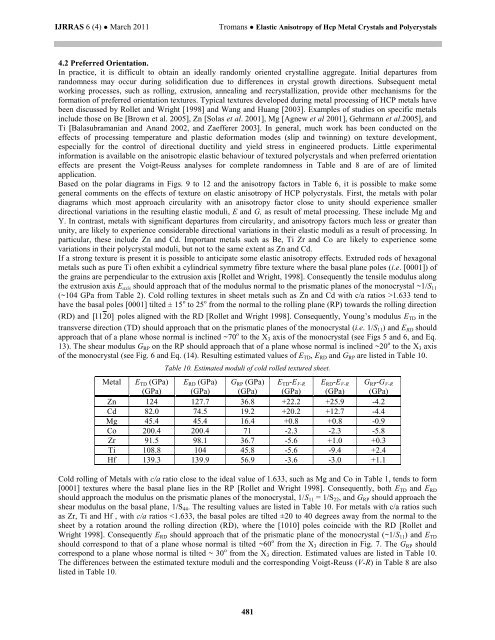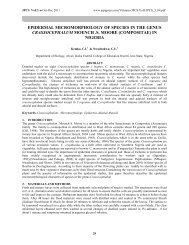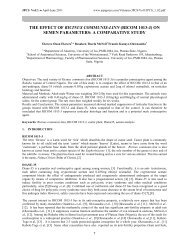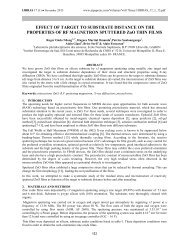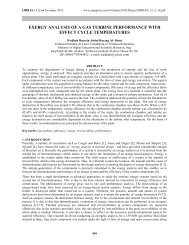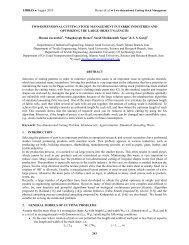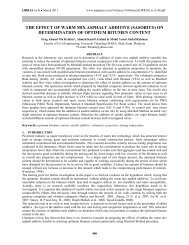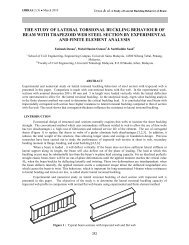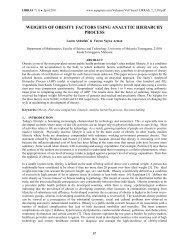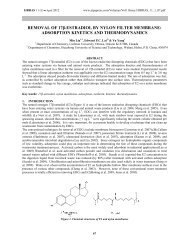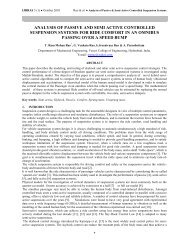elastic anisotropy of hcp metal crystals and polycrystals
elastic anisotropy of hcp metal crystals and polycrystals
elastic anisotropy of hcp metal crystals and polycrystals
You also want an ePaper? Increase the reach of your titles
YUMPU automatically turns print PDFs into web optimized ePapers that Google loves.
IJRRAS 6 (4) ● March 2011 Tromans ● Elastic Anisotropy <strong>of</strong> Hcp Metal Crystals <strong>and</strong> Poly<strong>crystals</strong><br />
4.2 Preferred Orientation.<br />
In practice, it is difficult to obtain an ideally r<strong>and</strong>omly oriented crystalline aggregate. Initial departures from<br />
r<strong>and</strong>omness may occur during solidification due to differences in crystal growth directions. Subsequent <strong>metal</strong><br />
working processes, such as rolling, extrusion, annealing <strong>and</strong> recrystallization, provide other mechanisms for the<br />
formation <strong>of</strong> preferred orientation textures. Typical textures developed during <strong>metal</strong> processing <strong>of</strong> HCP <strong>metal</strong>s have<br />
been discussed by Rollet <strong>and</strong> Wright [1998] <strong>and</strong> Wang <strong>and</strong> Huang [2003]. Examples <strong>of</strong> studies on specific <strong>metal</strong>s<br />
include those on Be [Brown et al. 2005], Zn [Solas et al. 2001], Mg [Agnew et al 2001], Gehrmann et al.2005], <strong>and</strong><br />
Ti [Balasubramanian <strong>and</strong> An<strong>and</strong> 2002, <strong>and</strong> Zaefferer 2003]. In general, much work has been conducted on the<br />
effects <strong>of</strong> processing temperature <strong>and</strong> plastic deformation modes (slip <strong>and</strong> twinning) on texture development,<br />
especially for the control <strong>of</strong> directional ductility <strong>and</strong> yield stress in engineered products. Little experimental<br />
information is available on the anisotropic <strong>elastic</strong> behaviour <strong>of</strong> textured poly<strong>crystals</strong> <strong>and</strong> when preferred orientation<br />
effects are present the Voigt-Reuss analyses for complete r<strong>and</strong>omness in Table <strong>and</strong> 8 are <strong>of</strong> are <strong>of</strong> limited<br />
application.<br />
Based on the polar diagrams in Figs. 9 to 12 <strong>and</strong> the <strong>anisotropy</strong> factors in Table 6, it is possible to make some<br />
general comments on the effects <strong>of</strong> texture on <strong>elastic</strong> <strong>anisotropy</strong> <strong>of</strong> HCP poly<strong>crystals</strong>. First, the <strong>metal</strong>s with polar<br />
diagrams which most approach circularity with an <strong>anisotropy</strong> factor close to unity should experience smaller<br />
directional variations in the resulting <strong>elastic</strong> moduli, E <strong>and</strong> G, as result <strong>of</strong> <strong>metal</strong> processing. These include Mg <strong>and</strong><br />
Y. In contrast, <strong>metal</strong>s with significant departures from circularity, <strong>and</strong> <strong>anisotropy</strong> factors much less or greater than<br />
unity, are likely to experience considerable directional variations in their <strong>elastic</strong> moduli as a result <strong>of</strong> processing. In<br />
particular, these include Zn <strong>and</strong> Cd. Important <strong>metal</strong>s such as Be, Ti Zr <strong>and</strong> Co are likely to experience some<br />
variations in their polycrystal moduli, but not to the same extent as Zn <strong>and</strong> Cd.<br />
If a strong texture is present it is possible to anticipate some <strong>elastic</strong> <strong>anisotropy</strong> effects. Extruded rods <strong>of</strong> hexagonal<br />
<strong>metal</strong>s such as pure Ti <strong>of</strong>ten exhibit a cylindrical symmetry fibre texture where the basal plane poles (i.e. [0001]) <strong>of</strong><br />
the grains are perpendicular to the extrusion axis [Rollet <strong>and</strong> Wright, 1998]. Consequently the tensile modulus along<br />
the extrusion axis Eaxis should approach that <strong>of</strong> the modulus normal to the prismatic planes <strong>of</strong> the monocrystal ~1/S11<br />
(~104 GPa from Table 2). Cold rolling textures in sheet <strong>metal</strong>s such as Zn <strong>and</strong> Cd with c/a ratios >1.633 tend to<br />
have the basal poles [0001] tilted ± 15 o to 25 o from the normal to the rolling plane (RP) towards the rolling direction<br />
(RD) <strong>and</strong> [ 1120]<br />
poles aligned with the RD [Rollet <strong>and</strong> Wright 1998]. Consequently, Young’s modulus ETD in the<br />
transverse direction (TD) should approach that on the prismatic planes <strong>of</strong> the monocrystal (i.e. 1/S11) <strong>and</strong> ERD should<br />
approach that <strong>of</strong> a plane whose normal is inclined ~70 o to the X3 axis <strong>of</strong> the monocrystal (see Figs 5 <strong>and</strong> 6, <strong>and</strong> Eq.<br />
13). The shear modulus GRP on the RP should approach that <strong>of</strong> a plane whose normal is inclined ~20 o to the X3 axis<br />
<strong>of</strong> the monocrystal (see Fig. 6 <strong>and</strong> Eq. (14). Resulting estimated values <strong>of</strong> ETD, ERD <strong>and</strong> GRP are listed in Table 10.<br />
Table 10. Estimated moduli <strong>of</strong> cold rolled textured sheet.<br />
Metal ETD (GPa) ERD (GPa) GRP (GPa) ETD-EV-R ERD-EV-R GRP-GV-R<br />
(GPa) (GPa) (GPa) (GPa) (GPa) (GPa)<br />
Zn 124 127.7 36.8 +22.2 +25.9 -4.2<br />
Cd 82.0 74.5 19.2 +20.2 +12.7 -4.4<br />
Mg 45.4 45.4 16.4 +0.8 +0.8 -0.9<br />
Co 200.4 200.4 71 -2.3 -2.3 -5.8<br />
Zr 91.5 98.1 36.7 -5.6 +1.0 +0.3<br />
Ti 108.8 104 45.8 -5.6 -9.4 +2.4<br />
Hf 139.3 139.9 56.9 -3.6 -3.0 +1.1<br />
Cold rolling <strong>of</strong> Metals with c/a ratio close to the ideal value <strong>of</strong> 1.633, such as Mg <strong>and</strong> Co in Table 1, tends to form<br />
[0001] textures where the basal plane lies in the RP [Rollet <strong>and</strong> Wright 1998]. Consequently, both ETD <strong>and</strong> ERD<br />
should approach the modulus on the prismatic planes <strong>of</strong> the monocrystal, 1/S11 = 1/S22, <strong>and</strong> GRP should approach the<br />
shear modulus on the basal plane, 1/S44. The resulting values are listed in Table 10. For <strong>metal</strong>s with c/a ratios such<br />
as Zr, Ti <strong>and</strong> Hf , with c/a ratios


